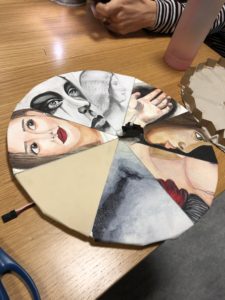My idea for my midterm changed a few times, beginning with a noise pollution detector, and then changing to a noise-canceling project to a wheel that spins depending on the pitch of the user’s voice. I just knew I wanted to do something with sounds. I wanted to discover more about sound sensors and how to link them to servos.
I couldn’t get a pitch reading using my RedBoard, so instead, I used a Teensy 3.2 board that can take in values and record the pitch and frequency of certain noises. It can also record a certain volume of sound. So I could set it to only read beyond a certain level of decibels and not below that.
 For the wheel, I have 7 pieces of art, the cloud one being the most irrelevant one of the batch, and the rest are there to highlight women’s day this weekend. I also realized that the paintings have nothing to actually relate to the whole “using pitch to reveal things” concept so I decided to create a side three-part story inspired by “Goldilocks and the Three Bears”. The father, mother, and baby bear are bound to have different pitches because of very apparent reasons. The user has to use the pitch of their voice and adjust it to fit the set tone to make the servo turn to the specific bear horrified at some strange girl touching their food.
For the wheel, I have 7 pieces of art, the cloud one being the most irrelevant one of the batch, and the rest are there to highlight women’s day this weekend. I also realized that the paintings have nothing to actually relate to the whole “using pitch to reveal things” concept so I decided to create a side three-part story inspired by “Goldilocks and the Three Bears”. The father, mother, and baby bear are bound to have different pitches because of very apparent reasons. The user has to use the pitch of their voice and adjust it to fit the set tone to make the servo turn to the specific bear horrified at some strange girl touching their food.
Midterm project: Done
thank u max for the vocal demonstration pic.twitter.com/BT6otOiA1f— Dabz (@nolongergrey) March 6, 2019
// Audio Tone Input
// Copyright 2013 Tony DiCola (tony@tonydicola.com)
// This code is part of the guide at http://learn.adafruit.com/fft-fun-with-fourier-transforms/
// Additions made by Aaron Sherwood 2019
#define ARM_MATH_CM4
#include <arm_math.h>
////////////////////////////////////////////////////////////////////////////////
// CONIFIGURATION
// These values can be changed to alter the behavior of the spectrum display.
////////////////////////////////////////////////////////////////////////////////
#include <Servo.h> // add servo library
Servo myservo; // create servo object to control a servo
int SAMPLE_RATE_HZ = 9000; // Sample rate of the audio in hertz.
const int TONE_LOWS[] = { // Lower bound (in hz) of each tone in the input sequence.
200, 400, 600
};
const int TONE_HIGHS[] = { // Upper bound (in hz) of each tone in the input sequence.
200, 400, 600
};
int TONE_ERROR_MARGIN_HZ = 0; // Allowed fudge factor above and below the bounds for each tone input.
int TONE_WINDOW_MS = 4000; // Maximum amount of milliseconds allowed to enter the full sequence.
///////////
////////// SET THRSHOLED HERE DHABIA
float TONE_THRESHOLD_DB = 15.0; // Threshold (in decibels) each tone must be above other frequencies to count.
///////////
///////////
const int FFT_SIZE = 256; // Size of the FFT. Realistically can only be at most 256
// without running out of memory for buffers and other state.
const int AUDIO_INPUT_PIN = 14; // Input ADC pin for audio data.
const int ANALOG_READ_RESOLUTION = 10; // Bits of resolution for the ADC.
const int ANALOG_READ_AVERAGING = 16; // Number of samples to average with each ADC reading.
const int POWER_LED_PIN = 13; // Output pin for power LED (pin 13 to use Teensy 3.0's onboard LED).
// any other changes to the program.
const int MAX_CHARS = 65; // Max size of the input command buffer
////////////////////////////////////////////////////////////////////////////////
// INTERNAL STATE
// These shouldn't be modified unless you know what you're doing.
////////////////////////////////////////////////////////////////////////////////
IntervalTimer samplingTimer;
float samples[FFT_SIZE * 2];
float magnitudes[FFT_SIZE];
int sampleCounter = 0;
char commandBuffer[MAX_CHARS];
int tonePosition = 0;
unsigned long toneStart = 0;
////////////////////////////////////////////////////////////////////////////////
// MAIN SKETCH FUNCTIONS
////////////////////////////////////////////////////////////////////////////////
void setup() {
// Set up serial port.
Serial.begin(38400);
myservo.attach(3); // attaches the servo on pin 9 to the servo object
// Set up ADC and audio input.
pinMode(AUDIO_INPUT_PIN, INPUT);
analogReadResolution(ANALOG_READ_RESOLUTION);
analogReadAveraging(ANALOG_READ_AVERAGING);
// Turn on the power indicator LED.
pinMode(POWER_LED_PIN, OUTPUT);
// Clear the input command buffer
memset(commandBuffer, 0, sizeof(commandBuffer));
// Begin sampling audio
samplingBegin();
}
void loop() {
// Calculate FFT if a full sample is available.
if (samplingIsDone()) {
// Run FFT on sample data.
arm_cfft_radix4_instance_f32 fft_inst;
arm_cfft_radix4_init_f32(&fft_inst, FFT_SIZE, 0, 1);
arm_cfft_radix4_f32(&fft_inst, samples);
// Calculate magnitude of complex numbers output by the FFT.
arm_cmplx_mag_f32(samples, magnitudes, FFT_SIZE);
// Detect tone sequence.
toneLoop();
// Restart audio sampling.
samplingBegin();
}
// Parse any pending commands.
parserLoop();
}
////////////////////////////////////////////////////////////////////////////////
// UTILITY FUNCTIONS
////////////////////////////////////////////////////////////////////////////////
// Compute the average magnitude of a target frequency window vs. all other frequencies.
void windowMean(float* magnitudes, int lowBin, int highBin, float* windowMean, float* otherMean) {
*windowMean = 0;
*otherMean = 0;
// Notice the first magnitude bin is skipped because it represents the
// average power of the signal.
for (int i = 1; i < FFT_SIZE / 2; ++i) {
if (i >= lowBin && i <= highBin) {
*windowMean += magnitudes[i];
}
else {
*otherMean += magnitudes[i];
}
}
*windowMean /= (highBin - lowBin) + 1;
*otherMean /= (FFT_SIZE / 2 - (highBin - lowBin));
}
// Convert a frequency to the appropriate FFT bin it will fall within.
int frequencyToBin(float frequency) {
float binFrequency = float(SAMPLE_RATE_HZ) / float(FFT_SIZE);
return int(frequency / binFrequency);
}
// Convert intensity to decibels
float intensityDb(float intensity) {
return 20.0 * log10(intensity);
}
////////////////////////////////////////////////////////////////////////////////
// SPECTRUM DISPLAY FUNCTIONS
///////////////////////////////////////////////////////////////////////////////
void toneLoop() {
for (int i = 0; i < sizeof(TONE_LOWS)/sizeof(int); i++) {
// Calculate the low and high frequency bins for the currently expected tone.
int lowBin = frequencyToBin(TONE_LOWS[i]);
int highBin = frequencyToBin(TONE_HIGHS[i]);
// Get the average intensity of frequencies inside and outside the tone window.
float window, other;
windowMean(magnitudes, lowBin, highBin, &window, &other);
window = intensityDb(window);
other = intensityDb(other);
// Check if tone intensity is above the threshold to detect a step in the sequence.
if ((window - other) >= TONE_THRESHOLD_DB) {
if (i == 0){
Serial.println("low triggered");
myservo.write(25);
toneDetected();
} else if (i == 1) {
Serial.println("mid triggered");
myservo.write(60);
toneDetected();
}
else if (i == 2) {
Serial.println("high triggered");
myservo.write(110);
toneDetected();
}
}
// // Check if the entire sequence was passed through.
// if (tonePosition >= sizeof(TONE_LOWS) / sizeof(int)) {
// toneDetected();
// tonePosition = 0;
// }
}
}
void toneDetected() {
// Flash the LEDs four times.
int pause = 150;
for (int i = 0; i < 4; i++) {
digitalWrite(POWER_LED_PIN, HIGH);
delay(pause);
digitalWrite(POWER_LED_PIN, LOW);
delay(pause);
}
}
////////////////////////////////////////////////////////////////////////////////
// SAMPLING FUNCTIONS
////////////////////////////////////////////////////////////////////////////////
void samplingCallback() {
// Read from the ADC and store the sample data
samples[sampleCounter] = (float32_t)analogRead(AUDIO_INPUT_PIN);
// Complex FFT functions require a coefficient for the imaginary part of the input.
// Since we only have real data, set this coefficient to zero.
samples[sampleCounter + 1] = 0.0;
// Update sample buffer position and stop after the buffer is filled
sampleCounter += 2;
if (sampleCounter >= FFT_SIZE * 2) {
samplingTimer.end();
}
}
void samplingBegin() {
// Reset sample buffer position and start callback at necessary rate.
sampleCounter = 0;
samplingTimer.begin(samplingCallback, 1000000 / SAMPLE_RATE_HZ);
}
boolean samplingIsDone() {
return sampleCounter >= FFT_SIZE * 2;
}
////////////////////////////////////////////////////////////////////////////////
// COMMAND PARSING FUNCTIONS
// These functions allow parsing simple commands input on the serial port.
// Commands allow reading and writing variables that control the device.
//
// All commands must end with a semicolon character.
//
// Example commands are:
// GET SAMPLE_RATE_HZ;
// - Get the sample rate of the device.
// SET SAMPLE_RATE_HZ 400;
// - Set the sample rate of the device to 400 hertz.
//
////////////////////////////////////////////////////////////////////////////////
void parserLoop() {
// Process any incoming characters from the serial port
while (Serial.available() > 0) {
char c = Serial.read();
// Add any characters that aren't the end of a command (semicolon) to the input buffer.
if (c != ';') {
c = toupper(c);
strncat(commandBuffer, &c, 1);
}
else
{
// Parse the command because an end of command token was encountered.
parseCommand(commandBuffer);
// Clear the input buffer
memset(commandBuffer, 0, sizeof(commandBuffer));
}
}
}
// Macro used in parseCommand function to simplify parsing get and set commands for a variable
#define GET_AND_SET(variableName) \
else if (strcmp(command, "GET " #variableName) == 0) { \
Serial.println(variableName); \
} \
else if (strstr(command, "SET " #variableName " ") != NULL) { \
variableName = (typeof(variableName)) atof(command+(sizeof("SET " #variableName " ")-1)); \
}
void parseCommand(char* command) {
if (strcmp(command, "GET MAGNITUDES") == 0) {
for (int i = 0; i < FFT_SIZE; ++i) {
Serial.println(magnitudes[i]);
}
}
else if (strcmp(command, "GET SAMPLES") == 0) {
for (int i = 0; i < FFT_SIZE * 2; i += 2) {
Serial.println(samples[i]);
}
}
else if (strcmp(command, "GET FFT_SIZE") == 0) {
Serial.println(FFT_SIZE);
}
GET_AND_SET(SAMPLE_RATE_HZ)
GET_AND_SET(TONE_ERROR_MARGIN_HZ)
GET_AND_SET(TONE_WINDOW_MS)
GET_AND_SET(TONE_THRESHOLD_DB)
}
